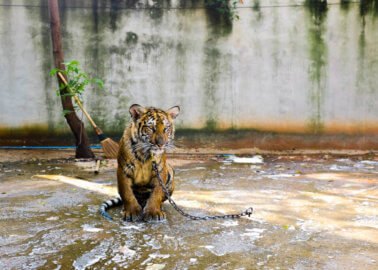9 Things to Look Out for Before You Visit an Animal Sanctuary
When you hear the word “sanctuary”, what comes to mind? A haven that’s safe, secure, and comfortable? For animals, a sanctuary is all of these things – or at least, it should be.
Genuine, reputable animal sanctuaries exist to help animals. However, many facilities that claim to be sanctuaries – including roadside zoos, some wildlife parks, breeding facilities, and other animal “attractions” – are really exploitative, moneymaking prisons. Their aim is to make a profit from visitors – most of whom are well-meaning people who want to help animals – and they subject the animals to appalling conditions.
We’ve put together some tips for identifying whether or not any facility claiming to be a sanctuary is genuine:
1. Find out whether the facility is accredited.
Animal-exploiting businesses commonly describe their facilities as “ethical” in their advertising and promotional materials. One way to avoid falling for such misleading claims is by checking whether the facility is accredited by the Global Federation of Animal Sanctuaries (GFAS). This organisation requires member sanctuaries to observe a strict code of ethics and meet animal welfare standards. They never breed or sell animals, and they allow rescued exotic animals to live out the rest of their days in peaceful, spacious, natural habitats with members of their own species.
2. Check the visiting times.
Genuine sanctuaries are likely to have limited public visiting hours in order to avoid any negative impact on the animals. Typically, they’re open only on specific days and at specific times, and you might need to book your visit in advance. Check the visiting times on the facility’s website or call to find out what they are, and if they’re not strictly limited, steer clear.
3. Scroll through the company’s social media.
Checking businesses’ social media accounts is a great way to find out about their practices before planning a visit. Look at the images they post to make sure they aren’t forcing animals to perform, chaining them, or promoting any other forms of cruelty, such as allowing visitors to touch the animals, take selfies with them, or ride them. If a facility doesn’t have a social media presence, simply search for its name and location to see whether visitors have posted photos taken there.
View this post on Instagram
4. Check how the animals are housed.
Reputable sanctuaries make every effort to replicate an animal’s natural habitat. Cramped pens with concrete floors and chain-link fences are red flags. Animals should share their space with suitable partners who can provide companionship and emotional stimulation. Assess whether they have enough room to engage in forms of behaviour that are natural for their species, such as running, swimming, or climbing. Enclosures should also be clean, and all animals should be able to access clean and fresh drinking water throughout the day.
5. Avoid facilities that let visitors touch animals.
A sanctuary should be a place of safety where animals can enjoy lives that are as close to being in the wild as possible – not a place where humans can touch, cuddle, or have extremely close contact with them. No reputable animal sanctuary allows any kind of hands-on interaction between visitors and animals, and that includes posing for photos. Such interactions are disruptive and frightening for animals – and endanger both the animals and visitors.
For example, in some sham sanctuaries, big-cat cubs are repeatedly woken up or kept awake so that they can be used as props in tourists’ photos, even though in their natural environment, they would sleep for about 20 hours a day. Numerous fake elephant sanctuaries allow visitors to ride elephants and bathe them, in addition to forcing them to “paint” or perform in shows.
View this post on Instagram
6. Find out what kind of enrichment is provided.
Animals should be offered multiple outlets for physical stimulation, such as expansive structures for chimpanzees to climb, ponds or pools for bears to bathe and splash in, and large fields for grazing. The aim of enrichment is to provide comfort for the animals – not to create an appealing scene for visitors, as is the case with most profit-driven facilities.
In addition to physical enrichment, the emotional needs of the animals should be a top priority. Animals should be placed with compatible companions of the same species, as doing so allows them to use their natural social abilities to form relationships, herds, and packs. In many true sanctuaries, the animal residents act as fellow “rehabilitators” who teach newcomers who have been abused how to get back in touch with their instincts and embrace their new environment.
7. Don’t fall for conservation claims.
Many companies claim to support species conservation in order to attract customers. The best way to avoid falling for such deception is to trust your gut and think logically – would a genuine sanctuary that intends to release animals back into the wild allow them to come into close contact with humans?
Any facility that breeds animals or buys them from breeders is not a sanctuary. Under the guise of “conservation”, some facilities inbreed Bengal tigers to produce white tigers – who suffer from multiple severe health issues – when in reality, they do so because white tigers fetch the most money from pseudo-sanctuaries and other exhibitors. But genuine sanctuaries know that breeding or buying animals could deplete their already limited resources, which should be put towards rescuing and protecting animals in need.
8. Be wary of volunteering projects.
It’s great that many people want to help animals directly by volunteering abroad or at a local sanctuary, and many sanctuaries do offer volunteering programmes that significantly benefit the animals involved. But taking part in volunteering projects run by sham sanctuaries merely puts more money in the pockets of animal-exploiters.
Handling animals who are sick, are injured, or have been psychologically disturbed by their previous circumstances and/or their move to the sanctuary requires extensive professional experience and highly specific skills, which most volunteers don’t have. Responsible programme leaders enlist volunteers with less specific skillsets for projects such as habitat enhancement or data collection, which benefit animals without requiring unnecessary human contact.
Countless animals are discarded by individuals who can’t provide them with adequate care – as well as by circuses, roadside zoos, laboratories, and other exploitative industries. Sanctuaries provide animals with a permanent home until the day they die. They don’t trade, borrow, or loan animals. Because they have limited funds, most try never to reward an abuser by buying an animal and will do so only in the most desperate of circumstances – provided that the abuser guarantees they’ll never acquire an animal of that species again. Animals who call a sanctuary their home likely had a rough start, and staff will be eager to tell you their individual stories so that you can learn more about the various industries that are harmful to animals.
Other Things You Can Do
If you want to learn about wild animals, watch a nature documentary that shows how they behave in their natural habitat. Or look around you! Become an expert on the wildlife in your local area, from hedgehogs in your garden to birds flying overhead.
Share these tips on social media to let your friends and family know how to discern a real animal sanctuary from a fake one:




